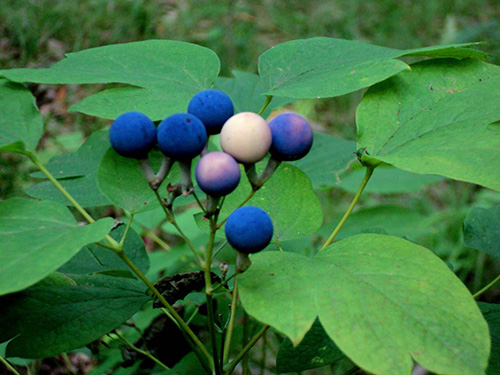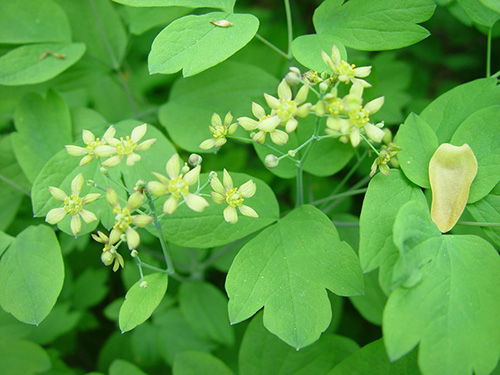Before getting into the many blue cohosh benefits, let’s learn more about this plant. Indigenous peoples and traditional healers have used numerous plants in nature for ages to treat various health issues. Blue cohosh (Caulophyllum thalictroides) is one such plant with a long herbal history. Many civilizations have used this perennial plant, native to North America, for its therapeutic qualities.
- Parts used medicinally – Rhizome.
- Properties – Antispasmodic, emmenagogue, oxytocic, diuretic.
- What it affects – Nerves, uterus, urinary tract, and joints.
Historical Background

The Iroquois, Cherokee, and Algonquin peoples, among other Native American groups, have long used blue cohosh. Historically, these cultures have used the plant’s roots for various medical purposes. The term “cohosh,” which describes the herb, is said to have come from the Algonquin word “cohos,” which means “rough,” perhaps alluding to the roughness of the plant’s root.
Blue Cohosh Benefits
Native American tribes and herbalists have prized this plant for its possible medicinal significance. Despite the herb’s well-established traditional applications, modern scientific study is shining light on the potential health advantages of blue cohosh.
Supporting Women’s Health
One of blue cohosh’s most well-known traditional applications is supporting women’s health. Indigenous peoples have traditionally used the plant to reduce pain and control menstrual cycles. Today’s herbalists speculate that blue cohosh may contain substances that might help regulate hormone levels and treat irregular menstruation. It is important to stress that more studies are necessary to verify these assertions and determine the herb’s safety for women’s health.
Potential Labor Support
Blue cohosh has drawn attention due to its potential to help labor and delivery. Traditional medicine practitioners often used the plant to speed up labor and facilitate childbirth. However, it is essential to emphasize that blue cohosh should only be used for labor induction. Before using any herbal medicines, pregnant women should always check their healthcare practitioners.
Anti-Inflammatory Properties
According to some early investigations, blue cohosh may have anti-inflammatory qualities. This potential may help treat diseases like arthritis and other respiratory disorders characterized by inflammation. These studies are still in their early phases, so further analysis is required to determine the full scope of blue cohosh’s anti-inflammatory benefits and safety profile.
Menstrual Cramp Relief
Blue cohosh may provide comfort for women who suffer from excruciating period cramps. This plant is suggested by some herbalists as a safe, all-natural treatment for lowering the pain and severity of menstrual cramps. Anecdotal evidence points to its effectiveness, but clinical investigations are required to confirm its advantages for this particular use.
Cardiovascular Support
Specific research suggests that the plant may have vasodilatory effects, which would help relax and expand blood vessels and enhance blood flow. However, additional study is necessary to understand the herb’s cardiovascular health effects thoroughly.
Blue Cohosh Side Effects
Blue cohosh users should be informed of the hazards associated with this plant, as with any herbal medicine. In this section, we shall examine blue cohosh’s adverse effects, highlighting the need for responsible usage and consulting a physician before using it in any health regimen.

Toxicity Concerns
One of the most significant issues is the possibility of toxicity with blue cohosh. The plant contains several bioactive substances, including alkaloids, which might have negative consequences when ingested in high amounts or over an extended length of time. High quantities of blue cohosh may cause nausea, diarrhea, vomiting, and lightheadedness. In extreme situations, it may result in heart and lung problems.
Pregnancy and Labor
Although blue cohosh has been used for centuries to aid delivery and labor, its use is hugely debatable. Some people think it might trigger labor by causing uterine contractions. Blue cohosh may cause excessive uterine stimulation, early labor, and other issues. Hence medical authorities strongly warn against taking it without a doctor’s supervision. Pregnant women should never use it since it might harm the mother and the unborn child.
Allergic Reactions
Those who have known sensitivities to members of the Berberidaceae family should proceed with great care when utilizing blue cohosh. Blue cohosh allergy symptoms might include skin rashes, itching, hives, or even life-threatening allergic reactions like anaphylaxis, which calls for rapid medical assistance.
Gastrointestinal Distress
Some consumers may develop stomach discomfort when consuming blue cohosh. This could include diarrhea, bloating, and cramping. If you have stomach problems, consult a healthcare provider immediately and abstain from the herb.
Interaction with Medications
Certain drugs and blue cohosh may interact, reducing effectiveness or raising the possibility of adverse side effects. To prevent drug interactions, you must speak with your doctor before using the plant or any other herbal supplement if you take any prescription drugs or have underlying medical issues.

Liver Toxicity
Blue cohosh has sometimes been linked to liver damage. Although such occurrences are rare, liver damage might conceivably result from prolonged or excessive plant usage. This herb should never be used by anybody with a weakened liver or problems related to the liver.
Use responsibly, as you would with any herbal medicine. Follow the dose guidelines, refrain from using it for an extended period, and stop using it immediately if you have any adverse effects. Always choose items of the highest quality from reliable suppliers. By being aware and careful, you may enjoy the plant’s possible advantages while lowering the danger of adverse effects.
Modern times call for caution while using blue cohosh, and it is crucial to speak with a licensed healthcare provider before including it in any health routine. As with any herbal treatment, scientific investigation is essential to comprehend its possible advantages and hazards. With further study, we can better understand blue cohosh’s rich herbal history and its potential use in contemporary healthcare practices.
Preparation and Dosage
- Infusion – Take 3 ounces 3 to 4 times daily.
- Decoction – Simmer for 5 to 15 minutes and take 1 to 2 ounces 3 to 4 times daily.
- Tincture – Take ½ to 1 teaspoon 3 to 4 times daily.
- Fluid Extract – Take 10 to 30 drops (1/6 to ½ teaspoon) 3 to 4 times daily.
- Powder – Take 1 to 5 #0 capsules (5 to 30 grains) 3 to 4 times daily.
NOTE – Blue cohosh is often combined with black cohosh because the herbs have complementary properties beneficial for the nerves and a strong antispasmodic effect on the entire system. It is combined with other herbs to promote their impact in treating bronchitis, nervous conditions, urinary tract ailments, and rheumatism.
WARNING – Blue cohosh should always be given only with other herbs indicated for the treated condition. It can be very irritating to mucous surfaces and can cause dermatitis on contact. The berries have poisoned children. It is best not to use either blue or black cohosh in teas because some active principles are unsuitable in water. Because of its emmenagogue properties, it is not to be used by pregnant women except during the last month of pregnancy.
Watch Before Taking Blue Cohosh
Health Disclaimer: The information on this website is for educational uses only and is not a substitute for professional medical advice. Always consult an authorized healthcare provider for any health concerns before using any herbal or natural remedy. We do not establish, treat, cure, or prevent any disease. Reliance on any material from this website is solely at your own risk. We are not responsible for any adverse effects resulting from the use of information or products mentioned on this website.
REFERENCES
- Vance Ferrell Harold M. Cherne, M.D. The Natural Remedies Encyclopedia [Book]. – Altamont, TN: Harvestime Books, 2010. – Vol. Seventh Edition: 7: pp. 146, 147. [blue cohosh benefits]
- National Institutes of Health (NIH)
- National Center for Complementary and Integrative Health (NCCIH)
- Memorial Sloan Kettering Cancer Center
- National Library of Medicine (PubMed)
